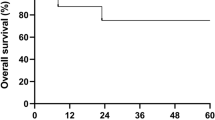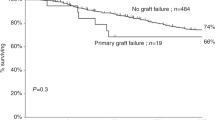Abstract
We performed stem cell rescue and allogeneic skin transplantation on a lethally neutron-irradiated nuclear accident victim. HLA-DRB1 mismatched unrelated umbilical cord blood cells (2.08 × 107/kg recipient body weight) were transplanted to an 8–10 Gy equivalent neutron-irradiated patient because of a lack of a suitable bone marrow or peripheral blood donor. Pre-transplant conditioning consisted of anti-thymocyte γ-globulin alone, and GVHD prophylaxis was a combination of cyclosporine (CYA) and methylprednisolone (mPSL). Granulocyte colony-stimulating factor (G-CSF), erythropoietin (EPO), and thrombopoietin (TPO) were concurrently administered after transplantation. The absolute neutrophil count reached 0.5 × 109/l on day 15, the reticulocyte count rose above 1% on day 23, and the platelet count was over 50 × 109/l on day 27, respectively. Cytogenetic studies of blood and marrow showed donor/recipient mixed chimerism. Rapid autologous hematopoietic recovery was recognized after withdrawal of CYA and mPSL. Repeated pathological examinations of the skin revealed no evidence of acute GVHD. Eighty-two days after the irradiation, skin transplantation was performed to treat radiation burns. Almost 90% of the transplanted skin engrafted. Immunological examination after autologous hematopoietic recovery revealed an almost normal T cell count. However, immune functions were severely impaired. The patient died from infectious complication 210 days after the accident.
Bone Marrow Transplantation (2002) 29, 197–204. doi:10.1038/sj.bmt.1703356
This is a preview of subscription content, access via your institution
Access options
Subscribe to this journal
Receive 12 print issues and online access
$259.00 per year
only $21.58 per issue
Buy this article
- Purchase on Springer Link
- Instant access to full article PDF
Prices may be subject to local taxes which are calculated during checkout




Similar content being viewed by others
References
Baranov A, Gale RP, Guskova A et al. Bone marrow transplantation after the Chernobyl nuclear accident New Engl J Med 1989 321: 205 212
Safety reports series No. 2 Diagnosis and treatment of radiation injuries International Atomic Energy Agency, Vienna 1998
Gluckman E, Broxmeyer HE, Auerbach AD et al. Hematopoietic reconstitution in a patient with Fanconi's anemia by means of umbilical cord blood from a HLA identical sibling New Engl J Med 1989 321: 1174 1178
Kurtzberg J, Laughlin M, Graham ML et al. Placental blood as a source of hematopoietic stem cells for transplantation into unrelated recipients New Engl J Med 1996 335: 157 166
Wagner JE, Rosenthal J, Sweetman R et al. Successful transplantation of HLA-matched and HLA-mismatched umbilical cord blood from unrelated donors: analysis of engraftment and acute graft-versus-host disease Blood 1996 88: 795 802
Cairo MS, Wagner JE . Placental and/or umbilical cord blood: an alternative source of hematopoietic stem cells for transplantation Blood 1997 90: 4665 4678
Gluckman E, Rocha V, Boyer-Chammard A et al. Outcome of cord-blood transplantation from related and unrelated donors New Engl J Med 1997 337: 373 381
Rubinstein P, Carrier C, Scaradavou A et al. Outcomes among 562 recipients of placental-blood transplants from unrelated donors New Engl J Med 1998 339: 1565 1577
Rocha V, Wagner JE, Sobocinski KA et al. Graft-versus-host diseases in children who have received a cord blood or bone marrow transplantation from an HLA-identical sibling New Engl J Med 2000 342: 1846 1854
Nagayama H, Nakayama K, Yasuo K et al. Immunological reconstitution after cord blood transplantation for an adult patient Bone Marrow Transplant 1999 24: 211 213
Report on the preliminary fact finding mission following the accident at the nuclear fuel processing facility in Tokaimura, Japan International Atomic Energy Agency, Vienna 1999
Sato K, Nagayama H, Takahashi TA . Aberrant CD3- and CD28-mediated signaling events in cord blood T cells are associated with dysfunctional regulation of Fas ligand-mediated cytotoxicity J Immunol 1999 162: 4464 4471
Hill RS, Peterson FB, Storb R et al. Mixed hematologic chimerism after allogeneic marrow transplantation for severe aplastic anemia is associated with a higher risk of graft rejection and a lessened incidence of acute graft-versus-host disease Blood 1986 67: 811 816
Huss R, Deeg HJ, Gooley T et al. Effect of mixed chimerism on graft-versus-host disease, disease recurrence, and survival after HLA-identical marrow transplantation for aplastic anemia or chronic myelogenous leukemia Bone Marrow Transplant 1996 18: 767 776
Storb R, Yu C, Wagner JL et al. Stable mixed hematopoietic chimerism in DLA-identical littermate dogs given sublethal total body irradiation before and pharmacological immunosuppression after marrow transplantation Blood 1997 89: 3048 3054
Yu C, Seidel K, Nash RA et al. Synergism between mycophenolate mofetil and cyclosporine in preventing graft-versus-host disease among lethally irradiated dogs given DLA-nonidentical unrelated marrow grafts Blood 1998 91: 2581 2587
Storb R, Yu C, Barnett T et al. Stable mixed hematopoietic chimerism in dog leukocyte antigen-identical littermate dogs given lymph node irradiation before and pharmacologic immunosuppression after marrow transplantation Blood 1999 94: 1131 1136
Storb R, Yu C, Zaucha JM et al. Stable mixed hematopoietic chimerism in dogs given donor antigen, CTLA-4Ig, and 100cGy total body irradiation before and pharmacologic immunosuppression after marrow transplant Blood 1999 94: 2523 2529
Storb R, Yu C, McSweeney P . Mixed chimerism after transplantation of allogeneic hematopoietic cells In: Thomas ED, Blume KG, Forman SJ (eds) Hematopoietic Cell Transplantation 2nd edn Oxford University Press: Malden, MA 1998 287 295
Thomson BG, Robertson KA, Gowan D et al. Analysis of engraftment, graft-versus-host disease, and immune recovery following unrelated donor cord blood transplantation Blood 2000 96: 2703 2711
Ab-Ghosh A, Goldman S, Slone V et al. Immunological reconstitution and correlation of circulating serum inflammatory mediators/cytokines with the incidence of acute graft-versus-host disease during the first 100 days following unrelated umbilical cord blood transplantation Bone Marrow Transplant 1999 24: 535 544
Giraud P, Thuret I, Reviron D et al. Immunue reconstitution and outcome after unrelated cord blood transplantation: a single paediatric institution experience Bone Marrow Transplant 2000 25: 53 57
Laughlin MJ, Barker J, Bambach B et al. Hematopoietic engraftment and survival in adult recipients of umbilical-cord blood from unrelated donors New Engl J Med 2001 344: 1815 1822
Giunan EC, Boussiotis VA, Neuberg D et al. Transplantation of anergic histoincompatible bone marrow allografts New Engl J Med 1999 340: 1704 1714
Acknowledgements
We thank Dr Yasuto Sasaki (Director of National Institute of Radiological Science, Chiba, Japan), and Prof Kazuhiko Maekawa (Chairman of Emergency Network Congress against Nuclear Accident, Department of Critical Care Medicine, University of Tokyo, Tokyo, Japan) for their excellent organization of the Network Congress. We thank Dr Katsuaki Sato (Department of Medical Zoology, University of Kagoshima, Japan), Prof Naoki Shirafuji (Department of Hematology, Teikyo University, Tokyo), Tetuya Kinugasa (Mitsubishi Industrial Kobe Hospital, Kobe, Japan), Masahiko Kimura, (Kyorin University, Tokyo), Dr Pablo Rubinstein (New York Blood Center, New York, NY), Prof Joanne Kurtzberg (Duke University, Durham, NC), and Dr Robert Peter Gale (Salick Health Care, Inc., Los Angeles, CA) for their critical comments and clinical intervention.
Author information
Authors and Affiliations
Rights and permissions
About this article
Cite this article
Nagayama, H., Misawa, K., Tanaka, H. et al. Transient hematopoietic stem cell rescue using umbilical cord blood for a lethally irradiated nuclear accident victim. Bone Marrow Transplant 29, 197–204 (2002). https://doi.org/10.1038/sj.bmt.1703356
Received:
Accepted:
Published:
Issue Date:
DOI: https://doi.org/10.1038/sj.bmt.1703356
Keywords
This article is cited by
-
Proteomics and secreted lipidomics of mouse-derived bone marrow cells exposed to a lethal level of ionizing radiation
Scientific Reports (2023)
-
Prognostic impact of chromosomal changes at relapse after allogeneic hematopoietic cell transplantation for acute myeloid leukemia or myelodysplastic syndrome
Bone Marrow Transplantation (2022)
-
Therapy-related myeloid neoplasms of recipient origin after allogeneic hematopoietic stem cell transplantation for acute leukemia
International Journal of Hematology (2022)
-
Clinical course of autologous recovery with chromosomal abnormalities after allogeneic hematopoietic stem cell transplantation
Bone Marrow Transplantation (2020)
-
Serum miR-375-3p increase in mice exposed to a high dose of ionizing radiation
Scientific Reports (2018)



